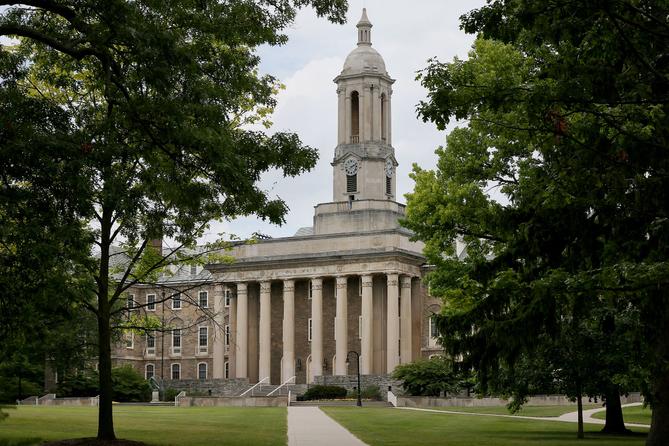A version of this story first appeared in Talk of the Town, a weekly newsletter by Spotlight PA’s State College regional bureau featuring the most important news and happenings in north-central Pennsylvania. Sign up for free here.
STATE COLLEGE — Penn State, the commonwealth’s largest public university, could cut dozens of jobs this year as it attempts to address a multimillion-dollar budget deficit that has already impacted universitywide projects.
At the April 25 meeting of the Faculty Senate, President Neeli Bendapudi said that there “may be 50 jobs that are in jeopardy this year” that individuals who lose their jobs will be given priority in hiring for other university positions.
“President Bendapudi has indicated there are limited layoffs anticipated this fiscal year,” the university wrote in an email to Spotlight PA. “It is estimated that less than 50 full-time employees will be impacted from across the University. … As units work to balance their budgets, units are also considering delaying program launches, deferring purchases or improvements, eliminating programs, measuring attrition and unfilled positions, and restructuring, as well as considering new ventures to increase revenues.”
However, Penn State’s layoff projection does not include fixed-term employees whose contracts will not be renewed, the university told Spotlight PA. Penn State said such contracts may not be renewed for reasons “beyond budgetary considerations, including, for example, when outside funding for such positions ends or when enrollment trends and careful analysis show certain programs are no longer viable.”
The university would not specify how much it expects to save by eliminating the roughly 50 full-time positions. Penn State also said it does not have an estimate of the number of research and teaching assistantships that could be cut.
The university’s layoff projection comes amid the university working to balance its budget by 2025, which includes reducing a projected $149 million deficit in the general funds budget, according to Penn State’s fiscal office.
Last year, some university trustees who had approved Penn State’s budgets for years expressed shock at the university’s deficit, as did Bendapudi.
Last summer, the university implemented a “strategic hiring freeze” to help address the shortfall, though exceptions were made for some positions. The administration also cited financial concerns in its decision to scrap the university’s promised Center for Racial Justice.
In March, Justin Schwartz, then-interim executive vice president and provost, directed chancellors, deans, and other university leaders to provide the administration with “your best estimate of the total number of positions from your unit that you predict are necessary to eliminate during this fiscal year,” according to internal communications obtained by Spotlight PA.
University leadership acknowledged in March that cuts to some units would go beyond the previously pledged 4% maximum per fiscal year under the new budget model. Penn State has declined to identify which units might receive greater-than-expected budget cuts. However, the College of Engineering is expected to make deeper cuts, and a university spokesperson told WPSU in March that it would be “impossible to avoid some layoffs” in the college.
The administration has said repeatedly there are no plans for mass layoffs.
The federal Worker Adjustment and Retraining Notification Act (WARN) requires employers to provide 60 days notice before a plant closing or mass layoff. The law applies when 500 or more people lose their jobs, or when between 50 and 499 people lose employment and the reduction affects at least one-third of the company’s workforce. Whether employers have to report layoffs of fixed-term employees depends on the terms of individual contracts.
Schwartz’s email to department heads in March specifically mentioned the university’s timeline must comply with the WARN Act.
SUPPORT THIS JOURNALISM and help us reinvigorate local news in north-central Pennsylvania at spotlightpa.org/statecollege. Spotlight PA is funded by foundations and readers like you who are committed to accountability and public-service journalism that gets results.

